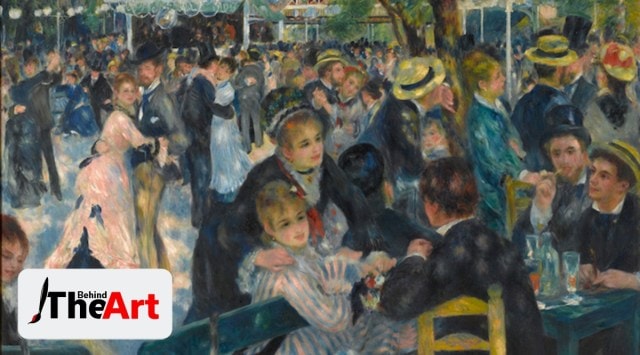- India
- International
Behind the Art: Why is Renoir’s ‘Bal du moulin de la Galette’ considered to be one of Impressionism’s most celebrated masterpieces?
Behind the Art: While the larger painting remained in France, the smaller version was sold at Sotheby's auction house in New York for $78 million in 1990, one of the most expensive artworks ever sold when it was purchased by Ryoei Saito. But what is the story behind Renoir's 'Bal du moulin de la Galette'? And why is the painting celebrated to date?
 Auguste Renoir's Bal du moulin de la Galette in 1876 (Source: Musée d’Orsay, Dist. RMN-Grand Palais / Patrice Schmidt)
Auguste Renoir's Bal du moulin de la Galette in 1876 (Source: Musée d’Orsay, Dist. RMN-Grand Palais / Patrice Schmidt)Bal du moulin de la Galette also known as Dance at Le moulin de la Galette is an 1876 painting by French artist Pierre-Auguste Renoir which is considered to be one of Impressionism’s most talked about masterpieces. It is worth millions of dollars and is currently housed at the Musée d’Orsay in Paris. The picture depicts a normal Sunday at the original Moulin de la Galette in Paris’s Montmartre neighbourhood. Working-class Parisians would dress up and hang around there until late in the 19th century, dancing, drinking, and enjoying galettes. Renoir also created a smaller version (78 x 114 cm) with the same title. While the larger painting remained in France, the smaller version was kept for many years by John Hay Whitney (US ambassador to the United Kingdom). Whitney’s surviving family sold the painting at Sotheby’s auction house in New York for $78 million in 1990. It was one of the most expensive artworks ever sold when it was purchased by Ryoei Saito (chairperson of the Daishowa Paper Manufacturing Company in Japan). But what is the story behind Renoir’s ‘Bal du moulin de la Galette’? And why is the painting celebrated to date?
The story behind the Art
In 1876, Pierre-Auguste Renoir created the famous dance piece Bal du Moulin de la Galette to experiment with light and showcase subjects in more detail. During that time, to capture the ever-changing world and its inhabitants, artists travelled to parks, streets, the beach, and other popular gathering spots. Plein-air paintings began to appear, filled with light and impatient gestures that only captured impressions rather than providing in-depth studies of their subjects. Bal du Moulin de la Galette exemplifies Renoir’s mature style of rich forms and fluid brushstrokes, and it was preceded by several studies, including a smaller piece similar to the original that Renoir used to explore the characters, dresses, dance, and moments he would present in the final version. The painting is now thought to be in possession of a private collection in Switzerland. The bigger version of the painting, which was completed only two years after the first Impressionist exhibition in Paris, displays aesthetic elements associated with the movement. Renoir painted his figures with loose brushstrokes and vibrant colours, and while some of them are dressed in black suits, a closer look reveals that even the darker areas were painted with multiple colours rather than pure black. The painting showcases certain people that the artist was close to. For example, Don Pedro Vidal de Solares y Cardenas, a Cuban painter who wears striped pants, is dancing with Marguerite Legrand, a model who goes by the name Margot. According to historians, she taught the Cuban painter how to dance polkas and helped him relax because he was too reserved. Renoir was by her side and nursed her until her death from typhoid two years later.
Legacy and importance
The painting is still a significant part of the collection at the Musée d’Orsay. It is praised not only for its distinctive style and monumental scale but also for its function as “a sign of Renoir’s artistic ambition.” Nevertheless, Bal du moulin de la Galette is more than just the artist’s best work -it is an Impressionist movement masterpiece. However, the content of the painting, which reveals a general social matrix of Paris in the 19th century and the crowd gathering at Moulin de la Galette, is just as fascinating as the Impressionist aspect. Georges Rivière, Renoir’s friend and art critic, provided information about the people depicted in the painting. In his memoir, Renoir and his Friends, Rivière describes the artist’s life and work in detail. Renoir built a studio in an old cottage near the Moulin de la Gallete so that he could paint the local scenery more easily. This painting, exhibited at the Impressionist exhibition in 1877, is undoubtedly Renoir’s most significant work from the middle of the 1870s. Even though some of Renoir’s friends are in the picture, his main goal was to show how lively and happy this popular dance garden on the Butte Montmartre was. Using vibrant, vivid brushstrokes, the study of the moving crowd in both natural and artificial light is done skillfully by the artist however, a few contemporary critics expressed disapproval due to the scene’s somewhat hazy appearance.
Renoir depicted popular Parisian life with his innovative style and intimidating format, a sign of Renoir’s artistic ambition. The painting is still admired in popular culture, and the cover art for Rod Stewart’s 1976 album A Night on the Town pays tribute to it by featuring Stewart in place of the man in the middle wearing a straw boater. This impressionist snapshot is still studied by many, and art lovers love to discuss what each character meant to the author or what meaning they hold in the scene.

(Next up in Behind the Art: What is the significance of Almond Blossom (1890) by Vincent van Gogh? Why is it priceless?)
📣 For more lifestyle news, follow us on Instagram | Twitter | Facebook and don’t miss out on the latest updates!
Apr 27: Latest News
- 01
- 02
- 03
- 04
- 05




































